Abstract
Antibiotics that contain a 1-N-methyl-5-thiotetrazole (MTT) side group have been associated with hypoprothrombinemia. In a detergent-treated rat liver microsomal system, MTT inhibited the carboxylation of the gamma carbon of glutamic acid, a necessary reaction in the synthesis of four of the clotting factors. In the present work, the inhibition by MTT was found to be slow in onset, with a lag time of 15 min before significant inhibition occurred. A preincubation of MTT with the microsomes decreased the lag time and increased the extent of inhibition. Glutathione at 1 mM was found to markedly decrease the ability of MTT to inhibit this reaction. The disulfide dimer of MTT was a more potent inhibitor of the system than was MTT, with inhibition detected as low as 1 microM dimer. Disulfiram also inhibited the carboxylation system. These results indicate that the sulfhydryl group of MTT is important for the inhibitory effect of MTT and suggest that a slowly formed metabolite of MTT may be directly responsible for the observed inhibition. The inhibitory mechanism of MTT may be analogous to that of disulfiram, which would explain some pharmacologic effects in common with disulfiram. In addition, the in vitro observations presented here and a closer examination of the clinical evidence raise the possibility that MTT-containing antibiotic-induced hypoprothrombinemia may not be a vitamin K reversible phenomenon.
Full text
PDF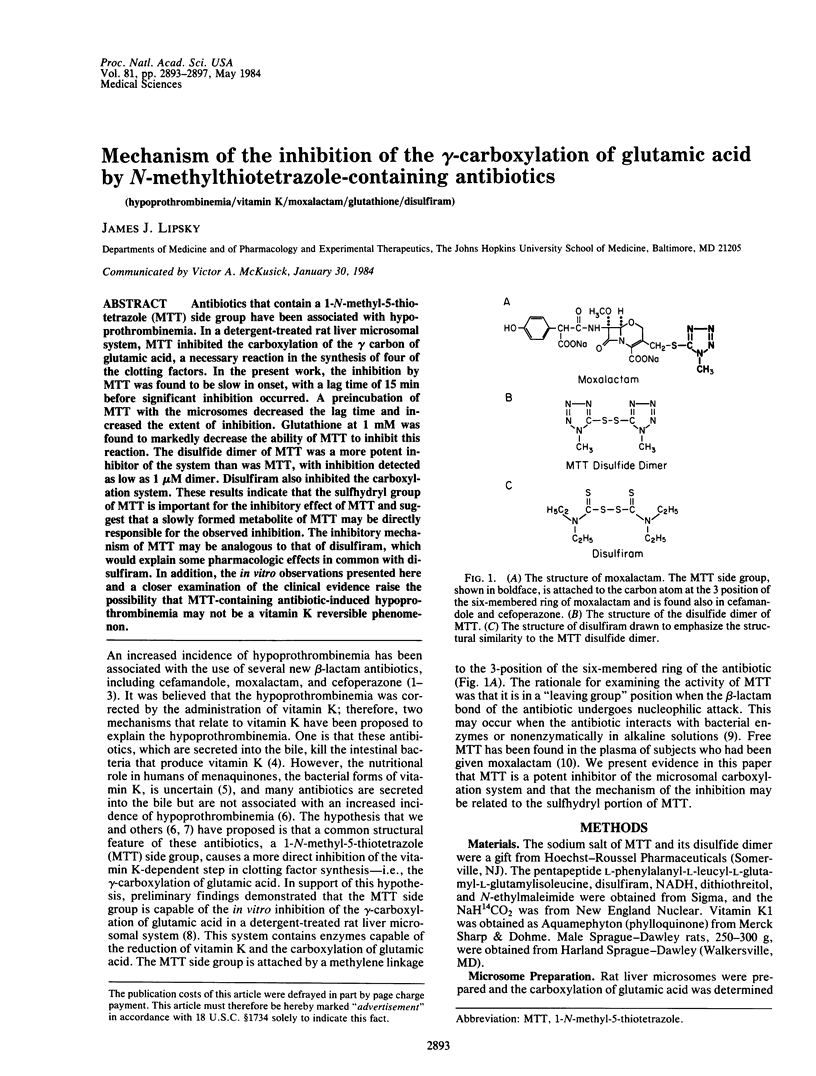
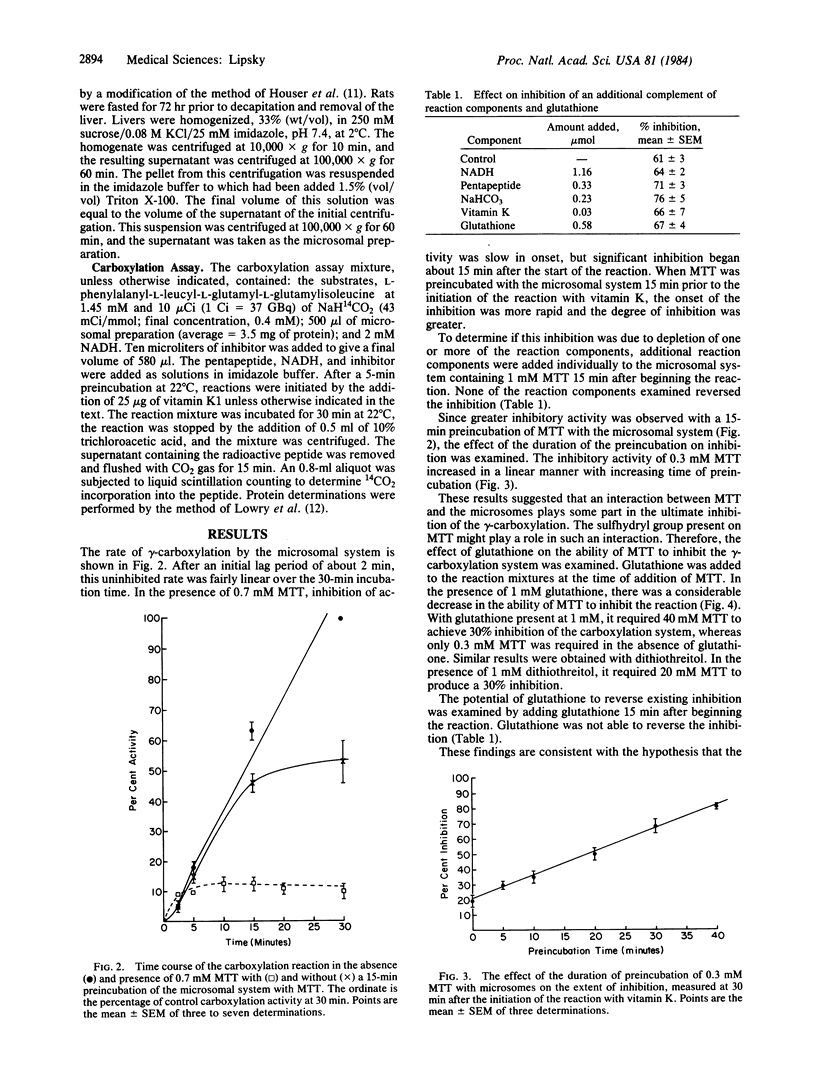
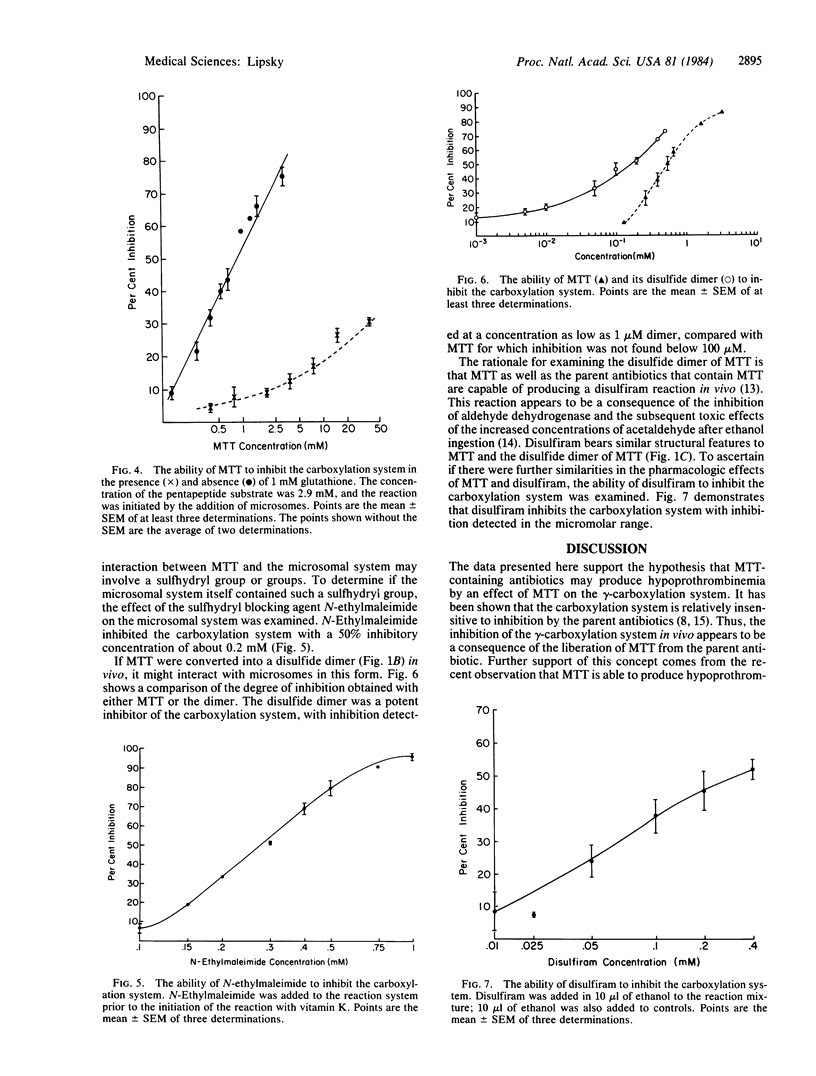
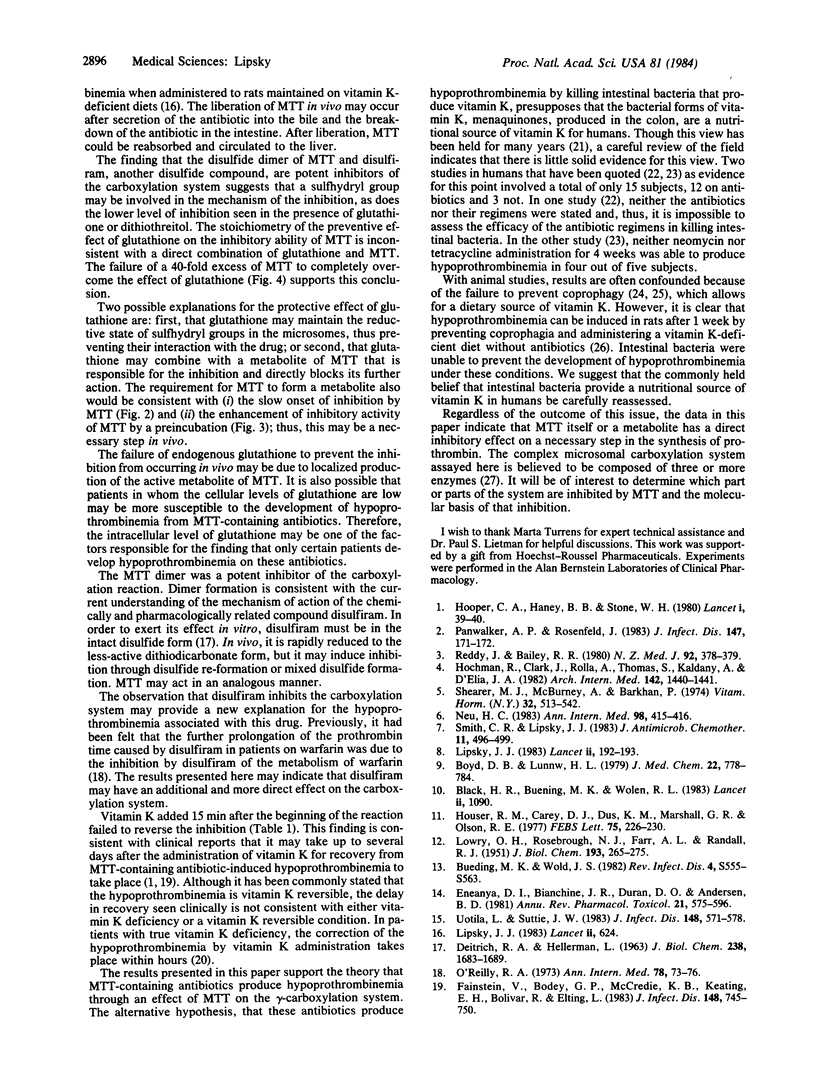
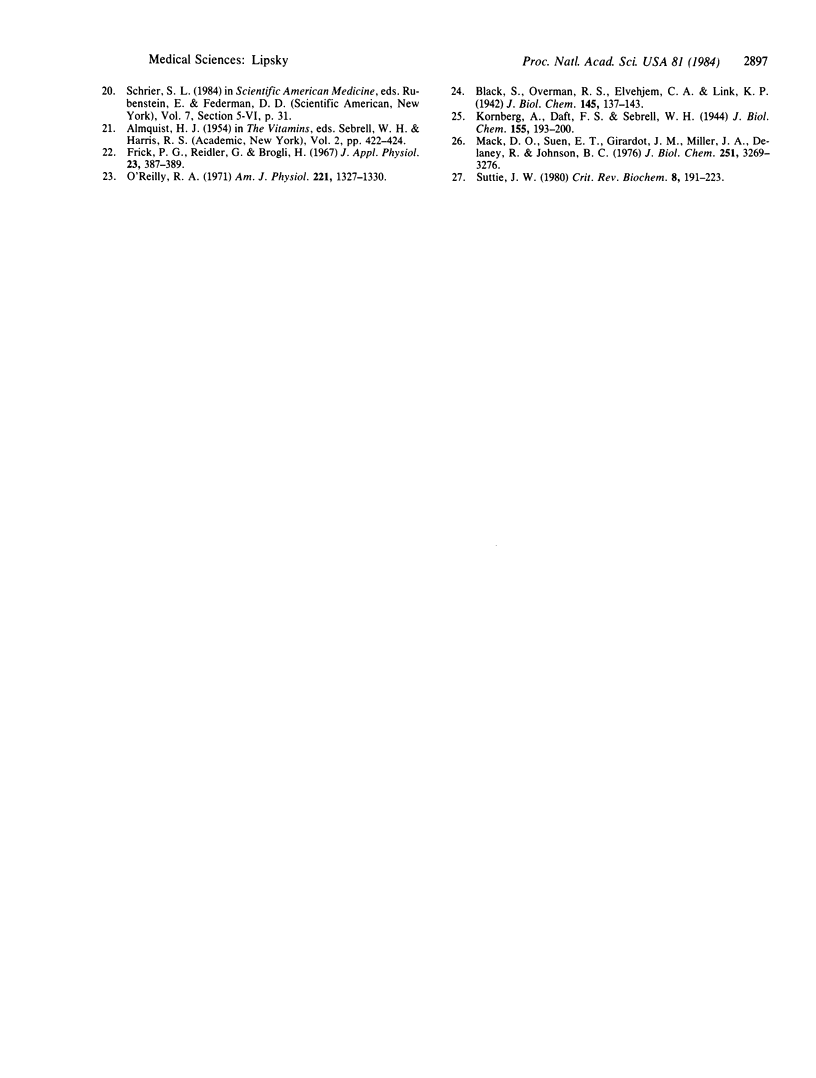
Selected References
These references are in PubMed. This may not be the complete list of references from this article.
- Black H. R., Buening M. K., Wolen R. L. Latamoxef, its side chain, and coagulation. Lancet. 1983 Nov 5;2(8358):1090–1090. doi: 10.1016/s0140-6736(83)91077-2. [DOI] [PubMed] [Google Scholar]
- Boyd D. B., Lunn W. H. Electronic structures of cephalosporins and penicillins. 9. Departure of a leaving group in cephalosporins. J Med Chem. 1979 Jul;22(7):778–784. doi: 10.1021/jm00193a006. [DOI] [PubMed] [Google Scholar]
- Buening M. K., Wold J. S. Ethanol-moxalactam interactions in vivo. Rev Infect Dis. 1982 Nov-Dec;4 (Suppl):S555–S563. doi: 10.1093/clinids/4.supplement_3.s555. [DOI] [PubMed] [Google Scholar]
- DEITRICH R. A., HELLERMAN L. Diphosphopridine nucleotide-linked aldehyde dehydrogenase. II. Inhibitors. J Biol Chem. 1963 May;238:1683–1689. [PubMed] [Google Scholar]
- Eneanya D. I., Bianchine J. R., Duran D. O., Andresen B. D. The actions of metabolic fate of disulfiram. Annu Rev Pharmacol Toxicol. 1981;21:575–596. doi: 10.1146/annurev.pa.21.040181.003043. [DOI] [PubMed] [Google Scholar]
- Fainstein V., Bodey G. P., McCredie K. B., Keating M. J., Estey E. H., Bolivar R., Elting L. Coagulation abnormalities induced by beta-lactam antibiotics in cancer patients. J Infect Dis. 1983 Oct;148(4):745–750. doi: 10.1093/infdis/148.4.745. [DOI] [PubMed] [Google Scholar]
- Frick P. G., Riedler G., Brögli H. Dose response and minimal daily requirement for vitamin K in man. J Appl Physiol. 1967 Sep;23(3):387–389. doi: 10.1152/jappl.1967.23.3.387. [DOI] [PubMed] [Google Scholar]
- Hochman R., Clark J., Rolla A., Thomas S., Kaldany A., D'Elia J. A. Bleeding in patients with infections. Are antibiotics helping or hurting? Arch Intern Med. 1982 Aug;142(8):1440–1442. [PubMed] [Google Scholar]
- Hooper C. A., Haney B. B., Stone H. H. Gastrointestinal bleeding due to vitamin K deficiency in patients on parenteral cefamandole. Lancet. 1980 Jan 5;1(8158):39–40. doi: 10.1016/s0140-6736(80)90571-1. [DOI] [PubMed] [Google Scholar]
- Houser R. M., Carey D. J., Dus K. M., Marshall G. R., Olson R. E. Partial sequence of rat prothrombin and the activity of two related pentapeptides as substrates for the vitamin K-dependent carboxylase system. FEBS Lett. 1977 Mar 15;75(1):226–230. doi: 10.1016/0014-5793(77)80092-6. [DOI] [PubMed] [Google Scholar]
- LOWRY O. H., ROSEBROUGH N. J., FARR A. L., RANDALL R. J. Protein measurement with the Folin phenol reagent. J Biol Chem. 1951 Nov;193(1):265–275. [PubMed] [Google Scholar]
- Lipsky J. J. Latamoxef-associated hypoprothrombinaemia. Lancet. 1983 Sep 10;2(8350):624–624. doi: 10.1016/s0140-6736(83)90707-9. [DOI] [PubMed] [Google Scholar]
- Lipsky J. J. N-methyl-thio-tetrazole inhibition of the gamma carboxylation of glutamic acid: possible mechanism for antibiotic-associated hypoprothrombinaemia. Lancet. 1983 Jul 23;2(8343):192–193. doi: 10.1016/s0140-6736(83)90174-5. [DOI] [PubMed] [Google Scholar]
- Mack D. O., Suen E. T., Girardot J. M., Miller J. A., Delaney R., Johnson B. C. Soluble enzyme system for vitamin K-dependent carboxylation. J Biol Chem. 1976 Jun 10;251(11):3269–3276. [PubMed] [Google Scholar]
- O'Reilly R. A. Interaction of sodium warfarin and disulfiram (antabuse) in man. Ann Intern Med. 1973 Jan;78(1):73–76. doi: 10.7326/0003-4819-78-1-73. [DOI] [PubMed] [Google Scholar]
- O'Reilly R. A. Vitamin K in hereditary resistance to oral anticoagulant drugs. Am J Physiol. 1971 Nov;221(5):1327–1330. doi: 10.1152/ajplegacy.1971.221.5.1327. [DOI] [PubMed] [Google Scholar]
- Panwalker A. P., Rosenfeld J. Hemorrhage, diarrhea, and superinfection associated with the use of moxalactam. J Infect Dis. 1983 Jan;147(1):171–172. doi: 10.1093/infdis/147.1.171. [DOI] [PubMed] [Google Scholar]
- Reddy J., Bailey R. R. Vitamin K deficiency developing in patients with renal failure treated with cephalosporin antibiotics. N Z Med J. 1980 Nov 26;92(672):378–379. [PubMed] [Google Scholar]
- Shearer M. J., McBurney A., Barkhan P. Studies on the absorption and metabolism of phylloquinone (vitamin K1) in man. Vitam Horm. 1974;32:513–542. doi: 10.1016/s0083-6729(08)60025-4. [DOI] [PubMed] [Google Scholar]
- Smith C. R., Lipsky J. J. Hypoprothrombinemia and platelet dysfunction caused by cephalosporin and oxalactam antibiotics. J Antimicrob Chemother. 1983 Jun;11(6):496–499. doi: 10.1093/jac/11.6.496. [DOI] [PubMed] [Google Scholar]
- Suttie J. W. Mechanism of action of vitamin K: synthesis of gamma-carboxyglutamic acid. CRC Crit Rev Biochem. 1980;8(2):191–223. doi: 10.3109/10409238009105469. [DOI] [PubMed] [Google Scholar]
- Uotila L., Suttie J. W. Inhibition of vitamin K-dependent carboxylase in vitro by cefamandole and its structural analogs. J Infect Dis. 1983 Sep;148(3):571–578. doi: 10.1093/infdis/148.3.571. [DOI] [PubMed] [Google Scholar]


